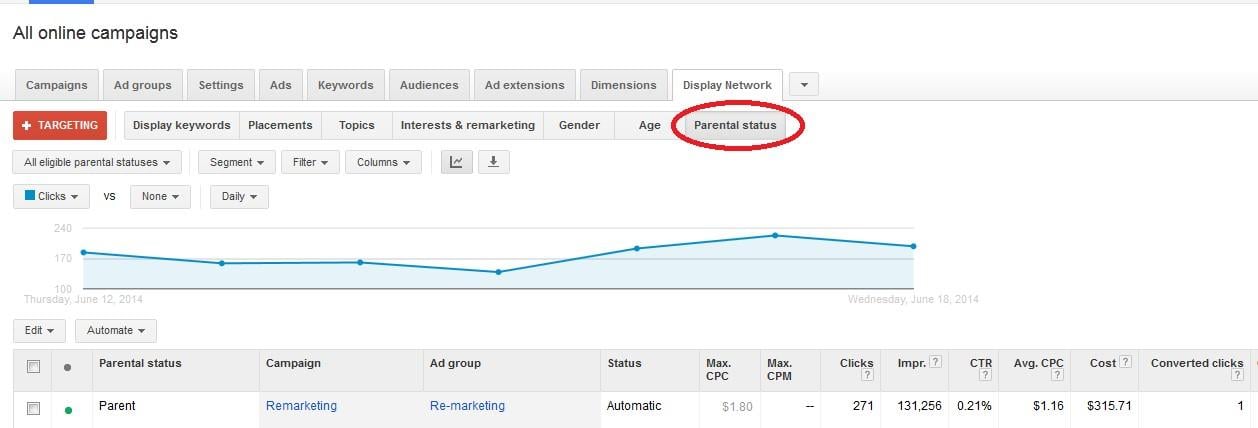If you’ve ever read “What to Expect When You’re Expecting”, you probably didn’t notice a chapter about Google tracking your parental status in AdWords. Well, this is exactly what Google is doing, as Parental Status is now a demographic subset that advertisers can explicitly target.
This feature went live within the past 12 hours or so, and Google has yet to make an official announcement. However, we’ve already seen it in action, as you can see in the following figure:
Our resident data scientist Mark Irvine was the first of us at WordStream to notice the new feature. At this point, parental status targeting hasn’t been rolled out across all advertiser accounts – in fact, even some of our largest marketing services accounts don’t have access to this functionality yet, suggesting that we’re still in the very early stages of the feature’s rollout.
Perhaps unsurprisingly, this demographic subset has three settings – “Parent”, “Not a parent” and “Unknown”, as you can see below. This allows advertisers to either exclude or adjust bids for these demographics, just as you would for the Age and Gender demographics. For specialty businesses (say, baby clothing retailers and children’s toy manufacturers), this could be incredibly valuable.
Obviously, the targeting potential of this feature is enormous. Imagine being able to capture new leads and conversions for visitors who just brought Junior back from the hospital! Of course, this means that I’ll almost certainly start seeing targeted ads, since my wife and I just welcomed Jules into the world…
This isn’t just a great way for advertisers to reach increasingly granular audiences with their advertisements, it’s also a glimpse into the possibilities of what Google could offer advertisers in the future. They’ve already supported targeting by Age, Gender, Interests, and now Parental Status. Could we eventually see demographic subsets based on race? Sexual orientation? The more data advertisers have the better (for them), but is Google going too far? I’m sure many of us remember the brouhaha Target found itself in when it started marketing coupons and other promotional offers to expectant teen mothers.
Whether Google will face a backlash over this new feature remains to be seen. For the time being, though, I’ve no doubt that many advertisers will be clamoring to get their hands on this new display targeting parameter!
Update: June 22, 2014
An official spokespeson from Google has notified us that: “Interest-based ads on our display network, including parental interests, have been around since 2009. We’ve made some changes to this in the Adwords interface for display campaigns. It uses the same system based on website visitation and users can edit or opt out of these ads on our Ads Settings page. As always, we don’t allow ads to be targeted to sensitive categories like health, race or sexuality.”
Separately, Daylan Pearce reached out to me to let me know that Google had posted a response in his Google Partners community group on June 10 regarding the new Parental Targeting feature. The following is an excerpt of Google’s response:
This is a new feature that’s rolling out to the US only. Right now it’s available to 5% of advertisers and later in June, it will be launched to 100% in US.
What are the benefits of this targeting type? Reach users who are likely to be parents with children in their household across the GDN. Harness the reach of our network and the precision of our parents data to find your audience at scale. There is no additional data fee to use our parental targeting; only pay for the impressions served.
How does parental targeting work? We used surveys to find hundred of thousands of respondents who are self-declared parents with children in their household. Our algorithm takes that data and find other users across our network that have similar Google Display Network and YouTube content consumption patterns and characteristics.
How does Google’s parental targeting compare to other providers? Our parental targeting has no associated data cost, unlike most 3rd party data solutions available elsewhere. We also expect our parental targeting’s combined reach & accuracy to be better than other providers. We welcome hearing your feedback once you’re up and running.
Why isn’t coverage higher? Why can’t I target 100% of US impressions with parental targeting? Only about 14% of users on the Internet are Moms with children in the household, so volume can often be limited when reaching this audience. Our coverage of this specific audience is actually quite significant.





0 Comments